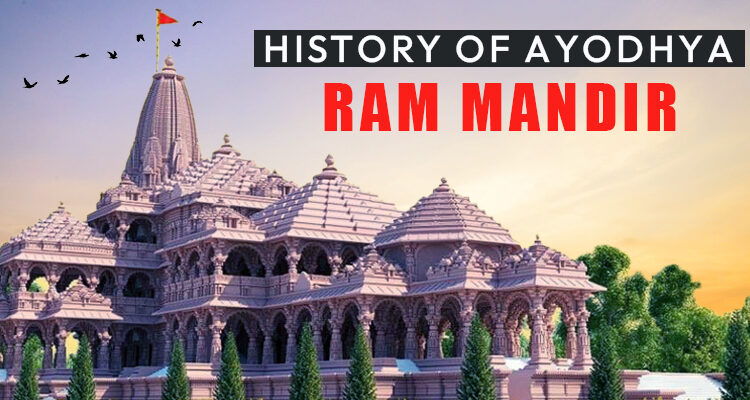- Advertisement -
Ram Mandir Ayodhya History : From 1528 To 2024 [Start From Babur Era]
- Advertisement -
Ram Mandir Ayodhya History: With the consecration of the Ram temple on January 22, 2024, the wait of almost 500 years for Ram devotees finally ended. With this, the dispute that had been going on for about 500 years ultimately ended. The controversy over the construction of the Ram temple in Ayodhya has been going on ever since Babar demolished the temple built here and built a mosque, which is about 500 years old. This controversy has been quite influential in politics since the country’s independence. Thousands and lakhs of people were killed in these 500 years. But now, after 500 years, the dream of every person in the country who wanted to see the Ram temple in Ayodhya has been fulfilled.
Read Also: Gyanvapi History: Whose Land Is It? Temples Or Mosques In The Gyanvapi Complex
Ram Mandir Ayodhya History
So let us tell you the complete Ram Mandir Ayodhya History, when the Ram Mandir-Babri Masjid land dispute started and what happened.
Year 1528:
The first Mughal emperor, Babur, constructed the Babri Masjid by demolishing the temple built there.
- Advertisement -
Year 1885:
Mahant Raghbir Das sought permission from the Faizabad court to build a temple around Babri Masjid. But his petition has been rejected.
December 22–23, 1949:
Ram Mandir Ayodhya History : This was the day when Lord Ram’s idols were mysteriously found inside the mosque. After this, the real controversy started.
Year 1950:
Gopal Visharad and Ramchandra Das sought permission from the Faizabad court to worship these idols.
Year 1959:
Nirmohi Akhara filed a petition regarding its rights on the disputed land.
Year 1961:
The Central Sunni Waqf Board, UP, moved the court to assert its rights over the disputed land inside the mosque and remove the idols.
February 1986:
Ram Mandir Ayodhya History: Faizabad court allowed Hindus to worship idols.
November 1989:
Rajiv Gandhi government allows Vishwa Hindu Parishad (VHP) to hold puja near the disputed site.
September 1990:
BJP leader Lal Krishna Advani started the Rath Yatra, which was impressive.
December 1992:
Karsevaks demolished Babri Masjid. Justice Liberhan Commission was formed to investigate.
Year 1993:
P.V. The Narasimha Rao government acquired 67 acres of land adjacent to the disputed site. The Supreme Court, in Dr. Ismail Faruqui’s decision, ended the takeover.
April 2002:
Ram Mandir Ayodhya History: Allahabad High Court started hearing the title suit.
March-August 2003:
- Advertisement -
On the instructions of the High Court, the Archeology Department excavated the disputed site. This excavation found evidence of remains similar to the temple beneath the mosque.
May 2003:
CBI filed a charge sheet against 8 people, including Advani, in the case of the demolition of Babri Masjid. Then, after this, incidents like Shankaracharya’s attempt at mediation, Advani’s starting worship in the temporary temple, and Advani’s being summoned to the court happened.
Read Also: Lok Sabha vs. Rajya Sabha : Difference Between Lok Sabha And Rajya Sabha
Year 2009:
The Liberhan Committee submitted the report of its investigation. And it was said that Babri Masjid was demolished through a well-planned conspiracy. In this, the names of BJP, Rashtriya Swayamsevak Sangh, Bajrang Dal, and Shiv Sena came up.
September 30, 2010:
The High Court ruled for a three-way division of the disputed property between Hindus, Muslims, and Nirmohi Akhara.
May 2011:
Ram Mandir Ayodhya History: The SC upheld the High Court’s decision on cross-appeals filed by the parties.
August 2017:
A three-judge bench of the Supreme Court led by Justice Deepak Mishra started hearing the appeal. The main issue was the side-track. The Muslim side referred to a controversial observation made in the Faruqui judgment that worship in mosques is not an integral part of Islam as per the Constitution.
January 2019:
A five-judge Constitution bench led by Chief Justice of India Ranjan Gogoi began hearing the appeal but suggested mediation.
August 6, 2019:
The mediation committee led by former Supreme Court judge Justice FMI Kalifulla failed to reach a consensus and initiate the court hearing.
August 6, 2019:
Supreme Court started hearing the Ayodhya case every day.
October 16, 2019:
The hearing of the Ayodhya case was completed, and the Supreme Court reserved its decision.
October 16, 2019:
Ram Mandir Ayodhya History: The constitution bench reserved the decision after 40 days of hearing.
Read Also: 20 Best Places To Visit In South India In 2024
November 9, 2019:
This was when the Constitution Bench gave its historic verdict on constructing the Ram Temple at the site that has been disputed for 500 years. In this decision, the government was ordered to provide 5 acres of land to Muslims at a suitable location in Ayodhya.
February 5, 2020:
Prime Minister Modi participated in laying the foundation stone of the Ram Temple.
January 22, 2024:
Lord Ram was consecrated in the temple on January 22, 2024. This is a matter of happiness for every Ram devotee.
- Advertisement -

